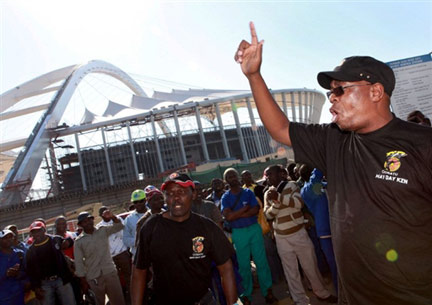Sport - Soccernomics
Buying their way to football glory
by Paul Myers
Article published on the 2009-12-20 Latest update 2010-01-09 14:07 TU

Striking construction workers at Durban's Moses Mabhiida 2010 World Cup football stadium - the money spent on the 2010 World Cup could build more than 200,000 homes in South Africa
(Photo: AFP)
Q+A: Simon Kuper, co-author Soccernomics
Most of us dream about what kind of football player we’d like to be: the tainted genius à la Maradona/Henry or the eternal Pelé.
But what kind of football club owner? The hands-off benefactor allowing an Arsène Wenger-type the time and resources to perfect his aesthetics? Or a flamboyant self-serving showman like the movie mogul turned Fiorentina chief Cecchi Gori?
The vignette on the Gori’s rakish handling of the Italian club is one of the racier episodes in Soccernomics by Simon Kuper and economist Stefan Szymanski.
There’d be a film in how an outfit boasting the Argentine striker Gabriel Batistuta and Portuguese playmaker Rui Costa zoomed from Serie A title challenges in the mid 90s to bankruptcy at the start of the millennium and back within the decade into the bonanza of the Uefa Champions League group stages where a win is worth around one million euros.
When Alberto Gilardino scored in stoppage time at Anfield in December 2009 to give Fiorentina victory over Liverpool and secure top spot in their Champions League group, the striker went to the away supporters to drink in the adulation.
While the burly forward was grandstanding, the Fiorentina suits were doubtless thinking about the market pool payments. And it’s that kind of phrase which would sit easily in a book which attempts to do for football what Moneyball did for baseball.
Soccernomics unleashes statistics with a Brechtian relish to rake through the sport and the Verfremdungseffekt is the potency of the piece.
Most England supporters, for example, believe their team has underachieved dreadfully.
Have a read of Soccernomics and you'll see that actually the boys from the British Isles have punched above their weight.
Other countries are bigger, have more or less the same income per capita and just as much if not more international experience. That’s why they do better.
I never thought that this "multiple regression" concept would become the blanket for my tears come the main event this summer.
But while such analytical constructs account for putative nearly-men, what about the bonafide minnows? If larger economic and sociological factors are at work, how will it ever change? When will there be a World Cup winner from Africa or Asia?
Simple. Import the knowledge networks that have brought success. Kuper fears the whiff of colonialism here, but is adamant that since the nous is in Europe, progress for the wannabes can only come this way.
But what of the decent African club players who don’t make the voyage to the promised land? The lucky ones will have a European coach imparting his excellence in Africa. But the brutal implication is that those who don’t even have that asset are, in an international context, a slack pass waiting to happen.
Pelé has predicted an African victor at the World Cup but Soccernomics suggests that’s not going to occur any time soon. Not until the vast majority of a squad is playing in Europe, at least
And can you really call it an African success when Yaoundé, Lagos, Abidjan or Kumasi are just anecdotal points of departure?
Kuper and Szymanski have pulled off a rare trick in marshalling the data to prove and provoke. They’re aided by a structure that allows stories to be told.
There’s no new analysis into how Lyon marched from provincial backwater to become the dominant force in French football.
The authors merely shine a light on the vision thing of another dynamic duo. Lyon chairman Jean-Michel Aulas and sporting director Bernard Lacombe acquire unheralded players such as Michael Essien and Karim Benzema. They perform and when the big clubs come a-courting, Lyon render up their wares for a hefty wedge.
That cycle brought riches and seven consecutive league titles between 2002 and 2008. With Bordeaux halting the run in 2009, the intrigue will be whether Lyon maintain their cunning.
Such tales leaven the load of numbers. But this slice of statistics is too heavy to bear: the nine billion rand spent on providing stadiums and infrastructure for the 2010 World Cup could build more than 200,000 homes in South Africa.
In a country where a third of the population lives on less than two dollars a day, that’s a mismatch of Barcelona v Southend United proportions.
The organisers know this and they know that the truth is out there. But they don’t even need to cover it up because we’re more than willing to be transported when the mothership of all sports arrives.
Resistance may be futile but at least Kuper and Szymanski have marked out the space where the oddities exist in the universal game







